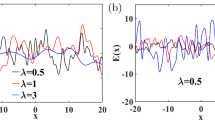Abstract
We analyze a system of ordinary differential equations modeling haplotype frequencies at a physically linked pair of loci, one selected and one neutral, in a population consisting of two demes with divergent selection regimes. The system is singularly perturbed, with the migration rate m between the demes serving as a small parameter. We use geometric singular perturbation theory to show that when m is sufficiently small, each solution not initially fixed for the same selected allele in both demes approaches one of a 1-dimensional continuum of equilibria. We then obtain asymptotic expansions of the solutions and show their validity on arbitrarily long finite time intervals. From these expansions we obtain formulas for the transient dynamics of F ST (a measure of population structure) at both loci, as well as for the rate of genotyping error if the allelic state at the selected locus is inferred from that at the neutral (marker) locus. We examine two cases in detail, one modeling two populations in secondary contact after a period of evolution in allopatry, and the other modeling the origination and spread of a resistance allele.
Similar content being viewed by others
References
Aguilar A., Roemer G., Debenham S., Binns M., Garcelon D., Wayne R.K. (2004) High MHC diversity maintained by balancing selection in an otherwise genetically monomorphic mammal. Proc. Natl. Acad. Sci. USA 101, 3490–3494
Aulbach B. (1984) Continuous and discrete dynamics near manifolds of equilibria. Springer, Berlin Heidelberg New York
Barton N.H. (2000) Genetic hitchhiking. Phil. Trans. R. Soc. Lond B 355, 1553–1562
Bürger R. (2000) The mathematical theory of selection, recombination, and mutation. Wiley, Chichester, UK
Christiansen F.B. (1975) Hard and soft selection in a subdivided population. Am. Nat. 109, 11–16
Crow J.F., Aoki K. (1984) Group selection for a polygenic behavioral trait: estimating the degree of population subdivision. PNAS 81, 6073–6077
Fenichel N. (1971) Persistence and smoothness of invariant manifolds for flows. Indiana Univ. Math. J. 21, 193–226
Fenichel N. (1974a) Asymptotic stability with rate conditions. Indiana Univ. Math. J. 23, 1109–1137
Fenichel N. (1974b) Asymptotic stability with rate conditions II. Indiana Univ. Math. J. 26, 81–93
Fenichel N. (1979) Geometric singular perturbation theory for ordinary differential equations. J. Diff. Eqs. 31, 53–98
Gillespie J.H. (2004) Population genetics: a concise guide, 2nd edn. Johns Hopkins University Press, Baltimore
Hartl D.L., Clark A.G. (1997) Principles of population genetics. Sinauer Associates, Sunderland, MA, USA
Haubruge E., Arnaud L. (2001) Fitness consequences of malathion-specific resistance in red flour beetle (Coleoptera: Tenebrionidae) and selection for resistance in the absence of malathion. J. Econ. Entomol. 94, 552–557
Hawthorne, D.J.: Personal communication, 19 June (2006)
Hawthorne D.J., Via S. (2001) Genetic linkage of ecological specialization and reproductive isolation in pea aphids. Nature 412, 904–907
Hirsch M., Smale S. (1974) Differential equations and dynamical systems, and linear algebra. Academic, San Diego
Hoppensteadt F.C. (1966) Singular perturbations on the infinite interval. Trans. Am. Math. Soc. 123, 521–535
Hoppensteadt F.C. (1971) Properties of solutions of ordinary differential equations with small parameters. Comm. Pure Appl. Math. 24, 807–40
Jones C.K.R.T. (1995) Geometric singular perturbation theory. In: Johnson R. (eds) Dynamical Systems: Montecatini Terme, 1994. Springer, Berlin Heidelberg New York, pp. 44–118
Kaplan N.L., Hudson R.R., Langley C.H. (1989) The “hitchhiking effect” revisited. Genetics 123, 887–899
Karlin S. (1975) General two-locus selection models: some objectives, results and interpretations. Theor. Pop. Biol. 7, 364–398
Kawecki T.J., Ebert D. (2004) Conceptual issues in local adaptation. Ecol. Lett. 7, 1225–1241
Maynard Smith J., Haigh J. (1974) The hitch-hiking effect of a favorable gene. Genet. Res. 23, 23–35
Miller J.R., Hawthorne D.J. (2005) Durability of marker-quantitative trait loci haplotypes in structured populations. Genetics 171, 1353–1364
Nagylaki T. (1974) Continuous selective models with mutation and migration. Theor. Popul. Biol. 5, 284–295
Nagylaki T. (1992) Introduction to theoretical population genetics. Springer, Berlin Heidelberg New York
Nagylaki T. (1999) Convergence of multilocus systems under weak epistasis or weak selection. J. Math. Biol. 38, 103–133
Nagylaki T., Crow J.R. (1974) Continuous selective models. Theor. Popul. Biol. 5, 257–283
Nilsson A.I., Kugelberg E., Berg O.G., Andersson D.I. (2004) Experimental adaptation of Salmonella typhimurium to mice. Genetics 168, 1119–1130
O’Malley R.E. (1991) Singular perturbation methods for ordinary differential equations. Springer, Berlin Heidelberg New York
Pannell J.R., Charlesworth B. (1999) Neutral genetic diversity in a metapopulation with recurrent local extinction and recolonization. Evolution 53, 664–676
Pannell J.R., Charlesworth B. (2000) Effects of metapopulation processes on measures of genetic diversity. Phil. Trans. R. Soc. Lond B 355, 1851–1864
Santiago E., Caballero A. (2005) Variation after a selective sweep in a subdivided population. Genetics 169, 475–483
Slatkin M., Wiehe T. (1998) Genetic hitch-hiking in a subdivided population. Genet. Res. 71, 155–160
Smith D.S. (1985) Singular-perturbation theory. Cambridge University Press, Cambridge
Stephan W., Wiehe T.H.E., Lenz M.W. (1992) The effect of strongly selected substitutions on neutral polymorphism: analytical results based on diffusion theory. Theor. Popul. Biol. 41, 237–254
Via S. (1999) Reproductive isolation between sympatric races of pea aphids. I. Gene flow restriction and habitat choice. Evolution 53, 1446–1457
Via S., Bouck A.C., Skillman S. (2000) Reproductive isolation between divergent races of pea aphids on two hosts. II. Selection against migrants and hybrids in the parental environments. Evolution 54, 1626–1637
Author information
Authors and Affiliations
Corresponding author
Electronic Supplementary Material
This file is unfortunately not in the Publisher's archive anymore: 285_2006_38_MOESM1_ESM.mw
Rights and permissions
About this article
Cite this article
Wood, B.P., Miller, J.R. Linked selected and neutral loci in heterogeneous environments. J. Math. Biol. 53, 939–975 (2006). https://doi.org/10.1007/s00285-006-0038-6
Received:
Revised:
Published:
Issue Date:
DOI: https://doi.org/10.1007/s00285-006-0038-6




